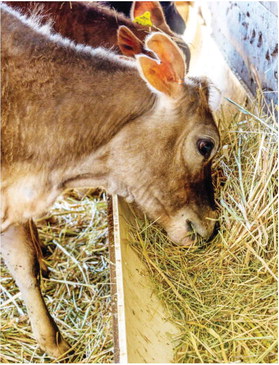Alternative Hay Sources On The Small Farm


Most livestock owners are very familiar with feeding alfalfa or grass hay. These perennial forage plants have good yield and nutritive quality, and they are widely grown on about 2.7 million acres in Montana. Alfalfa and perennial grasses do not need to be planted every year, and they provide many benefits, such as season-long growth, soil stabilization, nutrient recycling, wildlife feed and habitat, and aesthetic viewsheds. Despite the desirable qualities of perennial forages, there are numerous annual forages also grown for hay.
Why annual forages?
Annual crops are often used for emergency forage during droughty periods or following winterkill of alfalfa. However, annual forages are also very useful as hay or pasture during alfalfa renovation and land improvement projects. For example, on many Montana ranches, oat or barley hay is frequently grown when old stands of alfalfa are terminated for crop rotation purposes. Annual forages help maintain a reliable forage base and allow hay growers some good options for controlling difficult perennial weeds in alfalfa such as dandelions, thistles, and quackgrass. Annual forages are very adapted to both dryland (rainfed) and irrigated conditions, and are harvested on about 300,000 acres each year across Montana.
Which annual crops are good for forage?
Many different annual crops are used for pasture or hay, including small grains (wheat, barley, oat, triticale, spelt), millets, sudangrass, annual ryegrass, peas, turnips, and others. Across Montana, the most popular annual forages are small grains or “cereal” forages. Historically, awnless winter or spring wheat varieties were grown in the northern Great Plains — for the dual purpose of producing cash grain and forage to feed the draft animals used for farming. Presently, the most widely used cereals for hay are “hooded” (with drastically reduced awns) barley such as the variety ‘Haybet’; awnless varieties of winter wheat (such as ‘Willow Creek’); or winter triticale.
How should cereals be grown for hay?
Cereal crops are widely adapted across Montana, and the appropriate techniques for their planting, weed control and harvest are readily available. Contact your local MSU Extension county or reservation agent for specific practices suited to your area. The major difference among crop choice is the selection of a winter cereal versus a spring cereal forage. Winter cereals are planted in late summer or fall, whereas spring cereals are planted in the spring. In general, winter cereals are higher- producing than spring cereals, but in contrast, spring barley has superior forage quality compared to winter crops. One benefit of winter cereals is that planting in autumn when there may be fewer other tasks needing done can free up time during the busy spring season.
Annual forages are sown at 25 to 50 percent higher seeding rates than normally used for grain production. Standard small grain herbicides can be applied for weed control, however, the harvest or grazing interval following application prescribed on the herbicide label must be observed. Cereal forages should be harvested at the crop growth stage that optimizes forage yield, forage quality, and palatability – to mimic a “nice grass hay.” Cutting should occur during early heading (or flowering), which is generally 7 to 10 days following seed head emergence. Hay harvest delayed beyond the soft dough stage of the grain results in hay that is less nutritious and less tasty to animals.
Hay yields from annual forages in Montana range from less than one ton per acre for spring barley in dry years to greater than five tons per acre for winter cereals grown under high precipitation or irrigated conditions. Based on these forage production levels, cereal forages are ideal for use in rotation while renovating old alfalfa stands.
How should I feed cereal forages?
Cereal hay can be fed in hayracks, bunks or unrolled on the ground. Cereal hay can also be chopped in a hay processor before feeding, which is very useful for handling awned (or “bearded”) cereal crops. As with all forages, cereal hay should be fed based on the animal’s age and physiological status (e.g., pregnant vs. not, male vs. female) and the forage quality characteristics of the hay. Good quality hay from annual forages is well-suited to feeding to cattle, sheep and horses.
Are there any precautions for feeding cereal hay?
Two common concerns for cereal forages are their potential for nitrate toxicity and tetany. Cereal crops and weeds grown in certain environmental conditions can accumulate toxic levels of nitrate. High nitrate concentrations in forage or drinking water are most risky for pregnant livestock and can cause abortions or death. In recent MSU trials, the relative nitrate hazard generally appears to be: oat (high risk) > barley and spring cereals > winter cereals (lowest risk). Prior to hay harvest, a qualitative “Nitrate QuikTest” of standing cereals can be done in most Montana county and reservation Extension offices.
Tetany is a livestock condition that occasionally occurs in early growth of crested wheatgrass and other cool-season grasses (called “grass tetany”), but can also occur in animals fed harvested feeds (called “winter tetany”). Tetany results from an imbalance of potassium levels (high) versus those of calcium and magnesium (low). Cereal forages tend to have high forage potassium concentrations, so tetany symptoms can occur in ruminant animals (animals with four stomach compartments such as cows, sheep, and goats), but not in horses.
Despite these two limitations, cereal forages are very adaptable and offer many advantages. All cereal hay should be tested for protein, energy, nitrate, calcium, phosphorus, potassium, and magnesium by a laboratory analysis prior to feeding.


